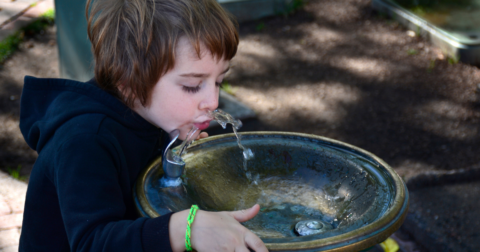Perspective
How Meat Became Cool Again in 2025
Diet•4 min read
Investigation
A new report documents how manure and other contaminants find their way into treated water.


Words by Nina B. Elkadi
Approximately 122 million people are exposed to potentially toxic byproducts in their drinking water. The possibly toxic mix is the result of organic material, like manure, interacting with disinfectants in the treatment process. According to a new report by the environmental non-profit Environmental Working Group, when the manure and other organic materials interact with chlorine, the result is a chemical byproduct that raises a number of health risks, including some that may have long-lasting health consequences for consumers.
“It’s not just that there’s manure in your water and that’s unsafe, but it’s that manure and other organic materials are then triggering these unsafe contaminants,” Environmental Working Group Midwest Director Anne Schechinger tells Sentient.
The 1.7 billion animals raised for consumption in the United States produce approximately 941 billion pounds of manure each year. Smaller water systems and residents living on private wells are especially vulnerable to agricultural pollution, but this new report raises another concern. The problem with disinfection byproducts — of specific concern in this report are trihalomethanes (TTHMs) — reaches cities including New York City and Los Angeles, which each had at least one test above the maximum contaminant level (MCL) set by the Environmental Protection Agency in the last five years.
From 2019 to 2023, the five years this report covers, the Washington Suburban Sanitary Commission (that serves the Washington D.C. suburb in Maryland) tested above the MCL level 218 times. TTHMs can form when chlorine interacts with a host of organic matter ranging from dead vegetation to, as this report states, manure.
In a 2021 notice the EPA drafted for water utilities to notify residents that they have high levels of TTHMs in their water, the regulators wrote: “Some people who drink water containing trihalomethane in excess of the MCL over many years may experience problems with their liver, kidneys, or central nervous system, and may have an increased risk of getting cancer.” Four years later, the regulatory landscape looks very different — the EPA is moving to dismantle Clean Water Act protections and the phrase “Safe Drinking Water” is banned at the Department of Agriculture.
The new report from EWG states that six of the 10 systems that tested at or above the maximum containment level at least once “are also listed among the states with the most livestock.” EWG cites research that documents how runoff from animal farms, and swine farms in particular, can contain extremely high levels of precursors that can turn into harmful chemicals during the disinfection process. Dairies are a major culprit too.
As cities grapple with multiple hot-button water issues from per- and polyfluoroalkyl substances (PFAS) to nitrate, the list of things to filter out seems to be continuing to grow. Water experts say disinfection byproducts like TTHMs could be filtered out with new technology targeting PFAS, if that regulation sticks.
“What unknown things that we don’t yet know are in our drinking water” are the “bread and butter” of Susan Richardson’s lab. Richardson is a professor of Chemistry and Biochemistry at the University of South Carolina, where she has been studying disinfection byproduct chemicals for around 30 years.
When we treat water, Richardson says, we’re killing harmful microbes. “But the problem is that the disinfection byproducts are an unintended consequence of trying to kill harmful pathogens,” she says.
Richardson says the interaction between the disinfectants and natural organic matter like manure can result in disinfection byproducts — as do tea leaves, algae and many other things produced in nature.
In 2024, the Biden Administration’s Environmental Protection Agency passed a new regulation to address PFAS, requiring public utilities to comply with new maximum contaminant levels in treated water.
Richardson’s opinion is that the regulatory approach to PFAS was rushed, and yet the outcome could have a silver lining. As utilities look to install new systems to filter out the PFAS, the systems can include filters that remove other contaminants too.
Certain filters, like granular activated carbon filters, can take out the precursor chemicals that lead to disinfection byproducts like TTHMs. They aren’t cheap. Richardson lives in Columbia, South Carolina, where the water plant serves around 375,000 customers. Installing that type of filtration system would cost the city approximately $200 million — not to mention approximately $24 million per year on upkeep.
In 2024, the EPA announced $1 billion in funding for communities and people on private wells impacted by PFAS contamination. Cities like Columbia plan to use this to partially fund their projects, if the funding remains.
The EWG report recommends starting to fix the problem at the source, in this case, they argue, on the farm. But under the Trump administration, funding for on-the-farm conservation practices aimed to reduce pollution in waterways is currently paused.
“When you take away hundreds of millions of dollars from cover crops and stream buffers and filter strips, you’re also taking away a reduction in nitrate and manure and other contaminants running off farm fields,” Schechinger says.
The Trump administration has not publicly commented on the future of PFAS, but just a few days ago, an anonymous EPA employee told the Guardian that the agency is considering a more lax approach to regulating chemicals such as PFAS.
“I think we have good water,” Richardson says, holding up her water bottle. “I’m drinking it. But, I think we can do better. I know we can do better, and I want us to do better.”